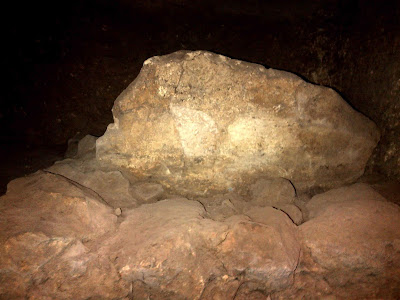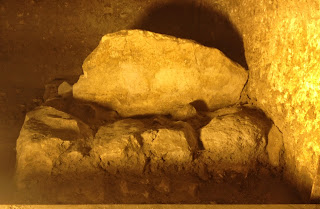 | |
|
Three well ordered events must occur in order that millions of Jews and hundreds of millions of Christians can realize their dreams of Moshiach. Think of these events as keys that unlock the great mystery, the one which the world has been waiting. But, I am not writing of mystery, instead I am writing of fact that Israeli society is becoming more religious and that the religious tend to vote for religious, conservative right wing politicians.
The first of these three events is underway. It occurs through the realignment of Israel’s political democracy through the Religious Ministry. The minister is responsible, in part for appointing the nations 300+ Rabbis who obtain their life-time nominations by a nationally representative electoral process. The regime is as old as the state of Israel, as are some of its appointees, but revival of its cultural and strategic importance make it the perfect vehicle for national religious, political revolution. Modern, qualified Rabbi’s being appointed to replace the old guard carry the burning torches of their constituents. Further, their group political empowerment is a short legislative bridge to self-determination and governmental representation in the form of Israel’s first upper house, the equivalent of its House of Lords.
With a Rabbinical upper-house Israel will restore its sovereign identity, once known as a Sanhedrin and with it the capacity to rule in all matters of law, both secular and religious. For the first time in thousands of years Israel will be in a position to converge laws, not because secular law can be invented, but because religious law, under such a recognized legal-religious body can ultimately adapt to unify the principles of its national law for all Israel.
The second of these three events, can only take place after Israel’s Upper House of elected Rabbi’s is legislated and Rabbi’s are seated as the nations representatives. As this Upper House realizes its popular, cultural, religious and spiritual duty it will be empowered to fulfil its legal responsibility to re-appoint the nations sovereign. In addition to the national Prime Minister and its President, the royal house of David and the appointment of a King over all Israel will finally be in the hands of the nation to realize its full identity. Israel’s land law’s and much of its present legislative processes are enhanced by the appointment of its Sovereign and only its Upper House of religious representatives has the power to ratify this appointment.
In the final step, with the appointment of the nations King and the re-establishment of the royal house all of the ceremonial functions of the King can be realized. This is expected to be an enormous boost to the nations constituents in spiritual and economic terms, particularly as a result of tourism and related industries that flow benefits to citizens of the country. The King with support of the nations President, Prime Minister, Cabinet and Upper and Lower Houses will then, by popular demand oversee the rebuilding of the third and final temple in Jerusalem.
The first of these three events is underway. It occurs through the realignment of Israel’s political democracy through the Religious Ministry. The minister is responsible, in part for appointing the nations 300+ Rabbis who obtain their life-time nominations by a nationally representative electoral process. The regime is as old as the state of Israel, as are some of its appointees, but revival of its cultural and strategic importance make it the perfect vehicle for national religious, political revolution. Modern, qualified Rabbi’s being appointed to replace the old guard carry the burning torches of their constituents. Further, their group political empowerment is a short legislative bridge to self-determination and governmental representation in the form of Israel’s first upper house, the equivalent of its House of Lords.
With a Rabbinical upper-house Israel will restore its sovereign identity, once known as a Sanhedrin and with it the capacity to rule in all matters of law, both secular and religious. For the first time in thousands of years Israel will be in a position to converge laws, not because secular law can be invented, but because religious law, under such a recognized legal-religious body can ultimately adapt to unify the principles of its national law for all Israel.
The second of these three events, can only take place after Israel’s Upper House of elected Rabbi’s is legislated and Rabbi’s are seated as the nations representatives. As this Upper House realizes its popular, cultural, religious and spiritual duty it will be empowered to fulfil its legal responsibility to re-appoint the nations sovereign. In addition to the national Prime Minister and its President, the royal house of David and the appointment of a King over all Israel will finally be in the hands of the nation to realize its full identity. Israel’s land law’s and much of its present legislative processes are enhanced by the appointment of its Sovereign and only its Upper House of religious representatives has the power to ratify this appointment.
In the final step, with the appointment of the nations King and the re-establishment of the royal house all of the ceremonial functions of the King can be realized. This is expected to be an enormous boost to the nations constituents in spiritual and economic terms, particularly as a result of tourism and related industries that flow benefits to citizens of the country. The King with support of the nations President, Prime Minister, Cabinet and Upper and Lower Houses will then, by popular demand oversee the rebuilding of the third and final temple in Jerusalem.
These are the reasons I no-longer dream of Moshiach, because I am close enough to Israel and its people to see and know that the nation is well on the way to realizing its cultural destiny. And if you think some may derail this train, like they did at Gush Katif, think again, Israel is bound to this cultural and indigenous destiny, its only a matter of time.






















